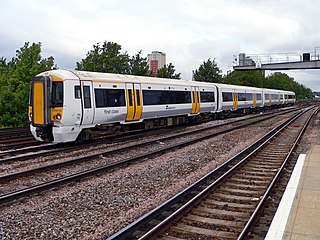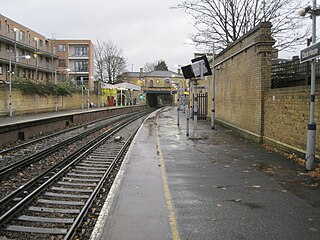
Maze Hill railway station is in Greenwich, London, and is situated on the Greenwich Line connecting suburbs along the south side of the River Thames with central London stations. The station is in the Maze Hill area of Greenwich, and is the closest station to Greenwich Park, being about 150m east of the north-east corner of the park. It is 4 miles 38 chains (7.2 km) down the line from London Bridge.

Lewisham is an interchange station in Lewisham, south-east London for Docklands Light Railway (DLR) and National Rail services.

South Eastern Trains was a publicly owned train operating company that operated the South Eastern Passenger Rail Franchise between November 2003, when it took over from Connex South Eastern, and 1 April 2006, when Southeastern began operating the new Integrated Kent franchise.

Catford Bridge railway station is on the Mid-Kent Line, serving Hayes line trains from London to Hayes. It lies between Ladywell and Lower Sydenham stations, 7 miles 42 chains (12.1 km) from London Charing Cross and in Travelcard Zone 3. It is adjacent to Catford railway station on the Catford Loop line. The station entrance is on Catford Road, a part of the South Circular Road (A205), and has brick buildings on both platforms, though the up side building is no longer in use by the railway. The station is managed by Southeastern, who operate all trains serving it.

Elmers End is a railway station and tram terminus in Elmers End, south London, England. It is in the London Borough of Bromley and on the railway it is 11 miles 7 chains (17.8 km) down the line from London Charing Cross.

Hayes railway station is a railway station located in Hayes in the London Borough of Bromley, south east London, England. It is 14 miles 32 chains (23.2 km) from London Charing Cross.

St Johns railway station is in the London Borough of Lewisham. It lies 5 miles 47 chains (9.0 km) down the South Eastern Main Line from London Charing Cross, and is situated between New Cross and Lewisham.

Ladywell railway station is in Ladywell, in the London Borough of Lewisham in south east London, in Travelcard Zone 3. It is 6 miles 62 chains (10.9 km) measured from London Charing Cross.

Lower Sydenham railway station is located on the boundary of the London Borough of Bromley and the London Borough of Lewisham in south-east London. It is 9 miles 2 chains (14.5 km) measured from London Charing Cross.

New Beckenham railway station serves Beckenham in the London Borough of Bromley in south-east London, in Travelcard Zone 4. It is 9 miles 44 chains (15.4 km) measured from London Charing Cross.

Clock House railway station is in the London Borough of Bromley in south east London, in Travelcard Zone 4 between Beckenham and Penge. It is 10 miles 23 chains (16.6 km) down the line from London Charing Cross. The station and all trains serving it are operated by Southeastern on the Hayes line.

West Wickham railway station serves West Wickham in the London Borough of Bromley. It is located in Southeast London and is in Travelcard Zone 5. It is 13 miles 19 chains (21.3 km) down the line from London Charing Cross.

Eden Park is a suburban area in Greater London, England, within the London Borough of Bromley, Greater London and prior to 1965, in the historic county of Kent. It lies south of Beckenham, west of Park Langley and Shortlands, north of West Wickham and Monks Orchard and east of Elmers End.

Kent House railway station is on the Chatham Main Line in England, serving part of the Penge and Beckenham areas in the London Borough of Bromley, south London. It is 7 miles 66 chains (12.6 km) down the line from London Victoria and is situated between Penge East and Beckenham Junction. It takes its name from the nearby Kent House farm, the first house in the historic county of Kent after crossing the Surrey border.

Sevenoaks railway station is a railway station on the South Eastern Main Line in England, serving the town of Sevenoaks, Kent. It is 22 miles 9 chains (35.6 km) down the line from London Charing Cross and is situated between Dunton Green and Hildenborough stations. Trains calling at the station are operated by Southeastern and Thameslink.

The Bromley North line is a less than 2-mile (3.2 km) long branch line in Greater London that connects at Grove Park with the South Eastern Main Line operated by Southeastern. During the 2010s the line which has two stations of its own has been served by a non-through (shuttle) service to and from Grove Park railway station in the London Borough of Lewisham. Network Rail records the line as route SO350.

The South Eastern franchise, also known as the Integrated Kent franchise, is a railway franchise for the provision of passenger services between London and Kent in South East England.

The Mid-Kent line is a British railway line running from Courthill Loop North junction to Hayes railway station in the London Borough of Bromley. Despite its name, none of the line is in the present-day county of Kent.

The Southbury Loop is a line linking Edmonton Green, in north-east London, to Cheshunt. It was opened by the Great Eastern Railway in 1891. Initially it was not very successful and was closed to passenger traffic in 1909. Goods trains continued to use the line and during World War I passenger services were reinstated for munitions workers. Once the war finished the line returned to its goods-only status although it was occasionally used for diversionary purposes when the West Anglia Main Line was closed south of Cheshunt. Electrification of the line and the reintroduction of passenger services in 1960 saw the line become busy with regular suburban services as part of the Lea Valley Lines network. Since May 2015 passenger services on the line are part of London Overground.
The Enfield Town branch is a suburban branch line in the England. In 2014 it is in fact the combination of the original Enfield branch which was built in 1849 by the Eastern Counties Railway (ECR) and a later line built by the Great Eastern Railway (GER) from Hackney Downs to Edmonton in 1872. The line is currently a double-tracked suburban railway with services running between Liverpool Street station and Enfield Town as well as some other services running from Liverpool Street to Cheshunt. Part of the original branch is closed and little visible remains today.




















